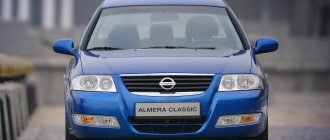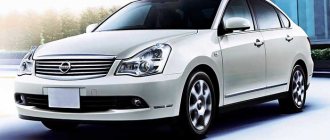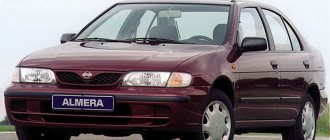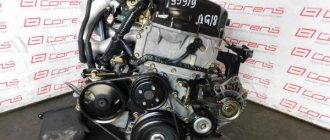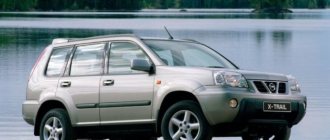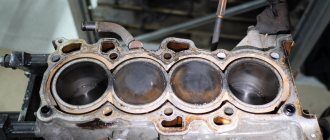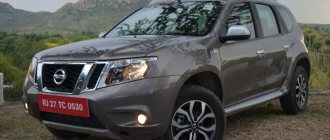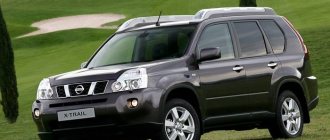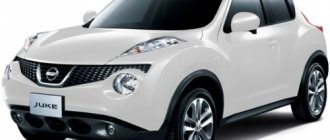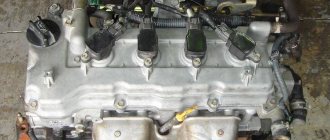Characteristics of Almera Classic
Almera Classic 2006 - 2012 was created by the Nissan concern as a further development of the previous Almera N16 model to replace the basic configuration of the Comfort sedan.
Before sales began in the Russian Federation, it was fully prepared for operation in Russian conditions. At the same time, the performance characteristics took into account the possibility of operation at low temperatures and insufficiently high indicators of the condition of road surfaces in our country. The factory assembly provides for the installation of 1.6 petrol engines (QG16DE) with a power of 109 hp. Depending on the specific model, the Almere Classic may have a manual or automatic transmission. In general, the car is characterized by low fuel consumption, simple operation and a high level of safety.
In the performance characteristics of the Almera Classic, the car manufacturer states the following data on the dimensions and interior design:
- length – 4510 mm;
- width – 1710 mm;
- height – 1440 mm
- trunk volume – 460 liters;
- number of seats – 5;
- Fuel tank volume – 55 liters.
- wheelbase – 2535 mm;
- turning radius – 5.3 meters;
ground clearance - 165 mm.
The total weight of the vehicle with a full tank is 1160 kg, with the possibility of an additional load of 540 kg.
Nissan Almera ground clearance, increasing ground clearance Nissan Almera – car blog
Nissan Almera's ground clearance or ground clearance, as for any other passenger car, is an important factor on our roads. It is the condition of the road surface or its complete absence that makes Russian motorists interested in the ground clearance of the Nissan Almera and the possibility of increasing ground clearance using spacers. To begin with, it’s worth honestly saying that the real ground clearance of the Nissan Almera may differ significantly from that declared by the manufacturer. The whole secret is in the method of measuring and where to measure ground clearance. Therefore, you can find out the real state of affairs only by arming yourself with a tape measure or ruler. The official ground clearance of the Russian-assembled Nissan Almera of the current generation is 160 mm. The model created on the basis of Renault Logan has the same indestructible suspension.
Some manufacturers use a trick and declare the amount of ground clearance in an “empty” car, but in real life we have a trunk full of all kinds of things, passengers and a driver. That is, in a loaded car the ground clearance will be completely different. Another factor that few people take into account is the age of the car and the wear and tear of the springs—their “sagging” due to age. The issue can be resolved by installing new springs or purchasing spacers for sagging Nissan Almera springs. Spacers allow you to compensate for spring subsidence and add a couple of centimeters of ground clearance. Sometimes even an inch of curb parking makes a difference.
More about Nissan: The compact Nissan Almera sedan has changed generations - Autoreview
But you shouldn’t get carried away with “lifting” the ground clearance of the Nissan Almera, because spacers to increase ground clearance are focused only on springs. If you do not pay attention to the shock absorbers, the travel of which is often very limited, then independently upgrading the suspension can lead to loss of controllability and damage to the shock absorbers. From the point of view of cross-country ability, high ground clearance in our harsh conditions is good, but at high speeds on the highway and in corners, serious sway and additional body roll appear.
Detailed video of installing spacers to increase ground clearance on a Nissan Almera in the N16 body.
Any car manufacturer, when designing the suspension and choosing the ground clearance, looks for a middle ground between handling and cross-country ability. Perhaps the simplest, safest and most unpretentious way to increase clearance is to install wheels with “high” tires. Changing wheels makes it easy to increase the ground clearance by another centimeter.
Do not forget that a serious change in ground clearance can damage the CV joints. After all, the “grenades” will have to work from a slightly different angle. But this only applies to the front axle. Moreover, a serious change in ground clearance can lead to uneven tire wear.
Motor characteristics
The Aichi Machine Indusnry company, in addition to the 4-cylinder engine of the basic QG16DE, with a volume of 1.6 liters, has developed two more similar options for the exact volume of 1.5 and 1.8 liters. Moreover, almost all Almera Classik supplied to Russia are equipped with a 1.6-liter engine with a cast iron cylinder block with a power of 109 hp. The timing system uses a chain drive, the approximate service life of which is 150,000 km.
The technological development adopted a standard set of functions for Nissan vehicles:
- variable valve timing on the intake shaft (CVTC);
- the presence of an electronic throttle;
- intake receiver with swirl flaps and some other improvements.
The engine installed in the car is designed for a budget car and therefore has no design features. Main technical and operational indicators:
- developed power – 107 hp. or 79 kW;
- maximum torque at 3600 rpm – 146 N/m;
- number of cylinders – 4;
- valves per cylinder – 4;
- cylinder diameter – 76 mm;
- compression ratio – 9.5;
- piston stroke – 88 mm;
- operating temperature - n.d.;
- acceleration to 100 km/h with 5 manual transmission - 12.1, with 4 automatic transmission - 13.9;
- maximum speed with manual transmission 184 km/h with automatic transmission 175 km/h;
- average fuel consumption – 7.9 l/100 km;
- lubricant change frequency - 10,000 km;
- permissible oil consumption – no more than 0.5 l/1000 km;
- engine oil volume – 2.7 l;
- food – injector.
Gear ratios in 4-speed automatic transmission:
The steering design of the Almera Classic car includes power steering.
Table of technical characteristics of Nissan Almera 2021 in a new body
| Petrol engine 1.6 l | |||||||
| Options | Welcome, Comfort, Tekna | ||||||
| Number of seats | Human | 5 | |||||
| ENGINE | |||||||
| Engine code | K4M | ||||||
| Number of cylinders, configuration | 4, in a row | ||||||
| Number of valves per cylinder | 4 | ||||||
| Engine capacity | cm3 | 1598 | |||||
| Bore/Stroke | mm | 79,5 / 80,5 | |||||
| Maximum power1 | kW (hp) / rpm | 75 (102) / 5750 | |||||
| Maximum torque | Nm/rpm | 145 / 3750 | |||||
| Compression ratio | 9,8 | ||||||
| Fuel type | Unleaded gasoline 92 octane | ||||||
| Fuel tank volume | l | 50 | |||||
| Fuel supply | Multipoint injection | ||||||
| Eco-standard | Euro 4 | ||||||
| TRANSMISSION | Welcome | Comfort | Tekna | Comfort | Tekna | ||
| Transmission | 5-speed manual | 4-speed automatic | |||||
| Drive unit | Front | ||||||
| Gear ratios | 1st gear | 3,727 | 2,725 | ||||
| 2nd gear | 2,048 | 1,499 | |||||
| 3rd gear | 1,393 | 1,000 | |||||
| 4th gear | 1,029 | 0,711 | |||||
| 5th gear | 0,821 | — | |||||
| reverse | 3,545 | 2,457 | |||||
| main couple | 4,214 | 4,703 | |||||
| Welcome | Comfort | Tekna | Comfort | Tekna | |||
| Suspension | front | Independent, spring mounted on McPherson struts | |||||
| back | torsion beam, springs | ||||||
| Steering | Rack and pinion type with hydraulic booster | ||||||
| Turning diameter from wall to wall | 11,4 | ||||||
| Turning diameter from curb to curb | 10,8 | ||||||
| Number of steering wheel turns from lock to lock | 3,18 | ||||||
| Brake system | front brakes are ventilated discs, rear brakes are drums; with ABS system | ||||||
| Wheels | 15 x 6J offset 50 mm | ||||||
| Tire size | 185/65R15 92H | ||||||
| DIMENSIONS AND WEIGHTS | |||||||
| Curb weight min./max.2 | kg | 1177/ 1179 | 1178/ 1193 | 1190/ 1198 | 1209/ 1224 | 1221/ 1229 | |
| Permissible gross weight | kg | 1600 | 1615 | 1620 | 1645 | 1650 | |
| Max. axle load | front | kg | 845 | 860 | 860 | 890 | 890 |
| back | kg | 795 | 810 | 805 | 810 | 810 | |
| Max. towed weight | with brakes | kg | 1100 | 1100 | 1100 | 950 | 950 |
| no brakes | kg | 614 | 614 | 614 | 630 | 630 | |
| Max. vert. load on the coupling device | kg | 103 | |||||
| Length | mm | 4656 | |||||
| Width | mm | 1695 | |||||
| Height | mm | 1522 | |||||
| Ground clearance | mm | 160 | |||||
| Wheelbase | mm | 2700 | |||||
| Front overhang | mm | 913 | |||||
| Rear overhang | mm | 1043 | |||||
| Luggage compartment volume (VDA) | l | 500 | |||||
| Fuel tank volume | l | 50 | |||||
| DYNAMIC PERFORMANCE AND FUEL ECONOMY | |||||||
| Fuel consumption3 | urban cycle | l/100km | 9,5 | 9,5 | 9,5 | 11,9 | 11,9 |
| suburban cycle | l/100km | 5,8 | 5,8 | 5,8 | 6,5 | 6,5 | |
| mixed cycle | l/100km | 7,2 | 7,2 | 7,2 | 8,5 | 8,5 | |
| CO2 emission | g/km | 171 | 171 | 171 | 201 | 201 | |
| Maximum speed | km/h | 185 | 185 | 185 | 175 | 175 | |
| Acceleration 0–100 km/h | sec | 10,9 | 10,9 | 10,9 | 12,7 | 12,7 | |
More about Nissan: Nissan Almera G15 - Forum, owner reviews, news, reviews, specifications, photos
1 In accordance with EU Directive 1999/99.
2 In accordance with EU Directive. The curb weight of the vehicle includes coolant, oil, fuel, spare tire and tools, excluding the driver, passengers, cargo and additionally installed equipment.
3 In accordance with EU Directive 1999/100. Additional equipment, driving technique, weather conditions, and road conditions can affect the results.
Gasoline consumption
The amount of fuel consumed depends on the design of the gearbox and the driving mode of the vehicle. For Almera Classic with 4 automatic transmission:
- in city conditions - 10.4 l/100 km;
- in the mixed cycle - 7.6 l;
- on the highway - 6.0 liters.
- in the urban cycle - 9.2 l/100 km;
- with mixed driving mode - 6.8 l;
- outside the city - 5.3 l.
As you can see, the most economical characteristics of a manual transmission when driving a car on a country highway.
The design of the rear suspension on the Almera Classic is a torsion beam with semi-independent qualities and good performance characteristics and an independent MacPherson strut on the front wheels.
The diameter of the wheels is 14 inches (R14). The recommended (standard) brand of tires for the wheels is 175/70 R14. It is possible to replace wheels with R15 using 185/65 R15 tires. The brakes are disc at the front and drum at the rear.
Nissan Almera | Body reference dimensions
Rice. 11.5. Installation of mudguards, side members and radiator trim panel: A1 = 1260 mm; A2 = 1547 mm; A3 =810 mm
Rice. 11.6. Control dimensions for installing the radiator trim panel and front suspension spring support cups: A4 = 840 mm; A5 = 990 mm
Rice. 11.7. Control dimension to determine the displacement of the front suspension spring support cups: A6 = 1220 mm
Rice. 11.8. Control dimensions for installing side members and cross members in the engine compartment: B1 = 660 mm; B2 = 955 mm
Rice. 11.9. Measuring the windshield opening:
Rice. 11.10. Control size of the front opening and relative position of the A-pillar and B-pillars: D1 = 1085 mm
Rice. 11.11. Dimensions allowing to evaluate changes in the geometry of the front doorway: D2 = 1325 mm; D3 = 857 mm
Rice. 11.12. Dimensions allowing to evaluate the change in the geometry of the rear doorway for a sedan body: D4 = 1040 mm; D5 = 840 mm
Rice. 11.13. Dimension determining the relative position of the middle and rear pillars for a sedan body: D6 = 876 mm
Rice. 11.14. Dimensions that allow you to evaluate the change in the geometry of the rear doorway for a station wagon body: D7 = 1088 mm;
Rice. 11.15. Dimension determining the relative position of the middle and rear pillars for a station wagon: D9 = 875 mm
Rice. 11.16. Dimensions determining the relative position of the B-pillars:
E1 = 1550 mm; E2 = 1370 mm; E3 = 1390 mm
Rice. 11.17. Measuring tool application points
Rice. 11.18. Rear window opening measurement diagram: F1 = 1245 mm
Rice. 11.19. Points of application of the measuring tool when measuring the diagonals of the rear window opening
Rice. 11.20. Reference dimensions of the rear cross member of the luggage compartment and the upper rear part of the trunk lid opening: G1 = 1240 mm; G2 = 975 mm
Nissan Almera Classic: technical specifications, length, dimensions and ground clearance
The Nissan Almera Classic car's technical characteristics are not particularly different from other cars in the Almera family. This is a classic C class sedan. It has a three-volume body, a spacious interior, and a medium trunk. Engine with a volume of 1.6 liters and a power of 107 horses, automatic transmission. Hydraulic control.
The machine is designed for urban and suburban use. Economy is average.
The cross-country ability is not sufficient for driving on forest roads, but on dirt roads and classic asphalt potholes the car does not perform so badly. It has proven itself well as a taxi car and a corporate car - it can withstand long-term daily use.
Dimensions and ground clearance of Nissan Almera Classic sedan 4 doors. 1st generation (N17) (2006 - 2013)
Dimensions Nissan Almera Classic sedan 4 doors.
| Length | 4510 mm |
| Width | 1710 mm |
| Height | 1440 mm |
| Wheelbase | 2535 mm |
| Front wheel track | 1490 mm |
| Rear wheel track | 1490 mm |
Ground clearance Nissan Almera Classic sedan 4 doors.
| Ground clearance (ground clearance without load) | 165 mm |
Competitors Nissan Almera Classic sedan 4 doors.
TagAZ Vortex Estina sedan 4 doors
see also
- — Photo and review of Nissan Almera Classic 1st generation (N17) sedan 4 doors.
- — All body types Nissan Almera Classic 1st generation (N17)
- — Nissan Almera Classic family by generation
- — Model range of Nissan cars
Nissan models
- Almera sedan 4 doors from 459,000 rub.
- GT-R coupe 2 doors from 4,670,000 rub.
- Juke hatchback 5 doors from 741,000 rub.
- Murano SUV 5 doors from 1,658,000 rub.
- Note hatchback 5 doors from 499,000 rub.
- Pathfinder SUV 5 doors. from 1,580,000 rub.
- Qashqai SUV 5 doors. from 789,000 rub.
- Qashqai+2 SUV 5 doors. from 844,000 rub.
- Teana sedan 4 doors from 1,043,000 rub.
- Tiida sedan 4 doors from 593,000 rub.
- X-Trail SUV 5 doors. from 1,093,000 rub.
- Battery for Matiz: remove and install
- Why your car won't start
- Signals between drivers: unwritten rules of the road
- What do these or other nameplates mean on the trunk of a car?
- Roadblocks: We analyze possible situations
"Wagens" is your assistant in choosing a new car. Catalog of car configurations and options with prices, technical specifications, photographs, official dealers in Russian regions, car insurance and car loans.
Characteristics
- number of doors – 4;
- seats – 5;
- trunk dimensions - 460 liters.
The car was positioned as a universal one, so it should be comfortable for everyone, and this was achieved. There are few options for adjusting the driver's seat - the distance to the pedals and the angle of the backrest change. The steering wheel is height adjustable. On the panel we see a standard set of instruments that will completely satisfy a novice motorist. For an experienced one, a little more will be required, but they can be added additionally during the tuning process.
A description of the interior would be incomplete without small details. The front seat backs have recesses that add some legroom for rear seat passengers. There is also an optional ashtray that can be used by the rear passenger. Most owners characterize the car's interior as very comfortable, suitable for long trips. It is no coincidence that this car is popular in taxis.
The car body has an already ordinary “blown” shape. Nothing particularly stands out among other cars. This is understandable - it was conceived as a simple universal machine for the entire planet, and doing something special, designer in this case would be fraught with danger.
Dimensions of the car:
- length – 4.51 meters;
- width – 1.71 meters;
- height – 1.44 meters.
These dimensions allow you to place the car in any medium-sized garage. There shouldn't be any problems with parking space either.
- base – 2.535 meters;
- track - 1.49 meters;
- full turning radius – 5.3 meters;
- ground clearance – 165 mm;
- tires - 175/70 R14.
Maneuverability is average, the turning radius is also not outstanding. Ground clearance is low. The ground clearance of the Nissan Almera Classic is almost the same as that of Renault Logan and AvtoVAZ classics, the minimum acceptable for our roads. The tires also indicate average, but quite sufficient, cross-country capability.
- maximum declared speed – 177;
- power indicator - 107 hp. With.;
- acceleration to hundreds of km – 13.9 seconds;
- load capacity – 515 kg;
- weight of an empty filled car – 1185;
- maximum weight – 1700.
As you can see, the car is not the most dynamic. The mobility parameter is much lower than even that of domestic cars, not to mention imported sports class cars. The characteristics are given for the version with automatic transmission, since most people drive with it, judging by the statistics on sales of used cars. The manual transmission has slightly better acceleration, and the load capacity is also higher with the same maximum weight. Read more about modifications and tuning possibilities.
- tank volume – 55 liters;
- gasoline brand - A-95;
- consumption per 100 km in the city is about 10 liters;
- consumption per 100 km on the highway - about 6 liters;
- oil – semi-synthetic, synthetic.
Consumption is normal for not very fast cars, but for such a mass it could be lower.
Its production began in 2002, when Samsung-Renault began producing a new multifunctional concept car in Korea. It was based on the principle of a universal, inexpensive car that would be in demand all over the world. It turned out quite well - a car for everyone.
The name Almera Classic has been known since 2006. It was in 2006 that the Renault-Samsung SM3 began to be sold on the markets of Russia and Ukraine under the name Nissan Almera Classic and had the same technical characteristics. The car differed slightly from the original version - the 2006 model for Russia was made with a different radiator grille, minor changes in the interior and had an automatic transmission - the prototype had a mechanic. This is not the only localization - there are many other subtypes of this machine for Latin America, Arab countries, Europe and the USA.
Nissan Almera sedan from AvtoVAZ
Nissan Almera (2020-2021) prices and equipment. Review of "Almera" (G15) with technical characteristics and photographs.
The inexpensive and spacious Nissan Almera sedan (in size it belongs to the “C-class”, but is built on the “B0” platform - used for “B-class” cars) for the Russian market was officially presented in August 2012 (at the ongoing motor show in Moscow).
Production of this car, which is essentially a “modernized Bluebird Sylphy of the 2005 model year,” was established at AvtoVAZ facilities and launched in December 2012. And by mid-April 2013 it went on sale.
The appearance of the “Russian Almera” has many similarities with the “Teana”, which, in our opinion, “played a cruel joke on it” - since it is still a small car and the attempt to make it “look like its older brother” turned out to be a little clumsy. Also “adds fuel to the fire” is the “frank budget” that is visible in the main elements of the exterior design (and the chrome radiator grille does not save the situation, but only “aggravates the contrast”)...
As we have already noted, despite the fact that Almera is built on a B-class platform, it has fairly large dimensions: length - 4656 mm (with a wheelbase - 2700 mm), height - 1522 mm and width - 1695 mm. The ground clearance of this sedan is 160 mm (optimal for our roads).
The trunk capacity corresponds to a volume of 500 liters. The curb weight of the sedan is 1198
1224 kg, and full - 1620 kg.
The interior of the three-volume Nissan Almera is classic – i.e. five-seater. There is more than enough free space here, but the finishing and layout are not particularly pleasing... The materials used are definitely of “average” quality, the appearance of the front panel does not cause any delight - everything is done “very simply and without frills.”
The rear seat in this sedan initially did not fold - so there was no way to “increase the trunk”, but since 2014, the back of the rear seat has been made folding in a 60/40 ratio - this “option” is available for all trim levels, with the exception of the “basic” one. (Welcome). Speaking of the rear sofa, it is quite spacious and does not feel too cramped even if you seat three passengers there.
Speaking about the technical characteristics of the Nissan Almera, I would like to note that much is borrowed from the Renault Logan (engine, transmission and some technical solutions).
The sedan is equipped with a non-alternative four-cylinder petrol power unit with a displacement of 1.6 liters (1598 cm³). This motor is capable of developing power up to 102 hp. at 5750 rpm, as well as 145 Nm of torque at 3750 rpm. Power is transmitted only to the front wheels via a 5-speed manual or 4-speed automatic transmission, to choose from.
The speed characteristics of the car are quite “competitive”: the maximum speed is 175-185 km/h, and the acceleration time from 0 to 100 km/h takes about 12.7 or 10.9 seconds (for automatic and manual, respectively).
The engine used complies with environmental standards of the Euro-4 standard, is “accustomed” to AI-92 and, moreover, is quite economical - the average fuel consumption declared by the manufacturer is 8.5
7.2 liters per 100 km in mixed driving mode.
It is also worth noting that the chassis of the AvtoVAZ Almera was further strengthened, taking into account the “specifics of Russian roads” and the size of the sedan. More durable suspension elements are designed to better cope with increased loads, ensuring ride comfort and safety. At the front, the developers used the usual design with MacPherson struts, but at the rear they preferred to use a torsion beam. The suspension is tuned to ensure a smooth ride on rough roads. The “fly in the ointment” for comfort is brought by narrow wheels (185/65), which often “fall” into various holes, but the large suspension travel compensates for this drawback, so most “road irregularities” are practically not felt in the cabin.
The steering mechanism on the Nissan Almera cannot be called “sharp”, but its responses are quite clear and timely, so there are no problems with the car’s handling (the steering uses a hydraulic booster). Ventilated brake discs are installed on the front wheels, and brake drums are used on the rear wheels.
A fairly high ground clearance allows this Nissan to demonstrate good off-road qualities. And even when fully loaded, the ground clearance does not fall below 145 mm, while allowing it to overcome “fords” up to 300 mm high. And considering that it also has serious protection for the crankcase and fuel lines, a trip to the dacha will not present any problems for the owners of this car.
In terms of safety, for a budget sedan, it is “decently packaged” - already in the basic equipment the car has two front airbags, an ABS + EBD system, front seat belts with load limiters, as well as anchors for child seats. In addition, the body in the front and rear parts is additionally reinforced with stiffeners - protecting during a collision.
In Russia, the 2021 Nissan Almera sedan is offered in four trim levels, and the “second” trim level has a couple of options, which in total brings the number of variations of the new product to five.
In all trim levels, the car receives a very wide range of basic equipment: an immobilizer, an additional brake light, front electric windows, an on-board computer, a tilt-adjustable steering column, an integrated antenna, a heated rear window, trunk lighting, height-adjustable headlights, a rear fog lamp, 15-inch steel wheels, steel crankcase protection, full-size spare wheel and a large-capacity washer reservoir (5 liters).
- In the basic “Welcome” version, the car is equipped exclusively with a manual transmission, fabric upholstery, audio equipment and black exterior door handles. The cost of the initial configuration is 641,000 rubles.
- The “comfortable” package includes: different fabric upholstery, heated front seats, a height-adjustable driver’s seat, central locking with remote control, front fog lights, heated and electrically adjustable mirrors, a central rear seat headrest, a function for automatically closing doors while driving and more advanced audio preparation (+ 2 speakers). The “Comfort” package without air conditioning is offered at a price of 667,000 rubles.
- And “Comfort” with air conditioning already costs 697,000 rubles.
- The last option, but with an automatic transmission, will increase in price to 752,000 rubles.
Reviews
Nissan Almera Classic: technical specifications, length, dimensions and ground clearance
The Nissan Almera Classic car's technical characteristics are not particularly different from other cars in the Almera family. This is a classic C class sedan. It has a three-volume body, a spacious interior, and a medium trunk. Engine with a volume of 1.6 liters and a power of 107 horses, automatic transmission. Hydraulic control.
The machine is designed for urban and suburban use. Economy is average.
The cross-country ability is not sufficient for driving on forest roads, but on dirt roads and classic asphalt potholes the car does not perform so badly. It has proven itself well as a taxi car and a corporate car - it can withstand long-term daily use.
History of the model
In 2006, Nissan decided to occupy the budget price segment of sedans, since previously there were no such cars in their lineup. The Classic model was built on the basis of the regular Almera. This decision was made due to the simplicity of the design, which made it possible to reduce the cost of creating a car and thereby fit into the budget class.
The car entered the Russian market in December 2006 in its first version. Options and modifications were quite scarce before the Nissan Almera Classic 2006 update. Technical specifications were modest, which affected the price.
In 2013, the company completed production of this model. Perhaps in the near future the Nissan concern will repeat the success of the Almera by releasing a new model of a budget sedan on a different platform.
https://youtube.com/watch?v=s7oQeLQdgw0
Characteristics
- number of doors – 4;
- seats – 5;
- trunk dimensions - 460 liters.
The car was positioned as a universal one, so it should be comfortable for everyone, and this was achieved. There are few options for adjusting the driver's seat - the distance to the pedals and the angle of the backrest change. The steering wheel is height adjustable. On the panel we see a standard set of instruments that will completely satisfy a novice motorist. For an experienced one, a little more will be required, but they can be added additionally during the tuning process.
A description of the interior would be incomplete without small details. The front seat backs have recesses that add some legroom for rear seat passengers. There is also an optional ashtray that can be used by the rear passenger. Most owners characterize the car's interior as very comfortable, suitable for long trips. It is no coincidence that this car is popular in taxis.
The car body has an already ordinary “blown” shape. Nothing particularly stands out among other cars. This is understandable - it was conceived as a simple universal machine for the entire planet, and doing something special, designer in this case would be fraught with danger.
Dimensions of the car:
- length – 4.51 meters;
- width – 1.71 meters;
- height – 1.44 meters.
These dimensions allow you to place the car in any medium-sized garage. There shouldn't be any problems with parking space either.
- base – 2.535 meters;
- track - 1.49 meters;
- full turning radius – 5.3 meters;
- ground clearance – 165 mm;
- tires - 175/70 R14.
Maneuverability is average, the turning radius is also not outstanding. Ground clearance is low. The ground clearance of the Nissan Almera Classic is almost the same as that of Renault Logan and AvtoVAZ classics, the minimum acceptable for our roads. The tires also indicate average, but quite sufficient, cross-country capability.
- maximum declared speed – 177;
- power indicator - 107 hp. With.;
- acceleration to hundreds of km – 13.9 seconds;
- load capacity – 515 kg;
- weight of an empty filled car – 1185;
- maximum weight – 1700.
As you can see, the car is not the most dynamic. The mobility parameter is much lower than even that of domestic cars, not to mention imported sports class cars. The characteristics are given for the version with automatic transmission, since most people drive with it, judging by the statistics on sales of used cars. The manual transmission has slightly better acceleration, and the load capacity is also higher with the same maximum weight. Read more about modifications and tuning possibilities.
- tank volume – 55 liters;
- gasoline brand - A-95;
- consumption per 100 km in the city is about 10 liters;
- consumption per 100 km on the highway - about 6 liters;
- oil – semi-synthetic, synthetic.
Consumption is normal for not very fast cars, but for such a mass it could be lower.
Its production began in 2002, when Samsung-Renault began producing a new multifunctional concept car in Korea. It was based on the principle of a universal, inexpensive car that would be in demand all over the world. It turned out quite well - a car for everyone.
The name Almera Classic has been known since 2006. It was in 2006 that the Renault-Samsung SM3 began to be sold on the markets of Russia and Ukraine under the name Nissan Almera Classic and had the same technical characteristics. The car differed slightly from the original version - the 2006 model for Russia was made with a different radiator grille, minor changes in the interior and had an automatic transmission - the prototype had a mechanic. This is not the only localization - there are many other subtypes of this machine for Latin America, Arab countries, Europe and the USA.
Owner reviews
- Dmitry, Moscow region. I have driven more than 400 thousand kilometers in my Almera. The car was produced in 2008, with a 1.6-liter engine and manual transmission. It’s clear that the engine is already tired and there aren’t enough stars in the sky. But the manual transmission works smoothly and squeezes all the juice out of the engine. The interior is nothing special, but what else would you expect from a budget car. It is noisy and there are only vibrations all around, tremors are transmitted to the steering column. Perhaps, in terms of comfort, the 2008 Nissan Almera is not much better than Russian cars like the VAZ-2110. But from a handling point of view, Almera is a clear leader. The sharp reactions to steering will be the envy of many foreign cars. The ground clearance is 140 mm, which is quite good only for asphalt roads. I’m afraid to go on dirt roads - the car is not new. I'm going to sell it. Almera served her time. A reliable car that will suit the needs of any taxi driver. I used my Almera for family purposes. Now it's time to switch to a new car.
- Nikolay, St. Petersburg. I have a 2012 Almera, I bought it to work in a taxi. Repainted it yellow. A car with a 1.6-liter 100-horsepower engine, which was also installed on Renault Logan. The gearbox is a five-speed manual, characterized by clear and short strokes. The box works quickly, there are no complaints about it. An engine with a power of 100 horsepower is enough for a leisurely drive, due to the peculiarities of the body - it is too high and narrow, because of this the aerodynamics deteriorate. At the same time, fuel consumption increases. Unfortunately, only the version with a 1.6-liter engine is supplied to Russia. But in terms of practicality, my Almera outperforms most competitors - it has a spacious interior for five tall passengers, as well as powerful air conditioning and interior heating. In addition, I would also like to note the large trunk. If necessary, you can fold the rear seat backs and transport long items, which is very convenient and practical. A suspension with a ground clearance of 160 mm is a decent result for a sedan adapted to Russian conditions.
- Igor, Orel. I like everything about this car, because when choosing a car I hit the nail on the head. Nissan Almera fully meets my needs, as well as the needs of my wife and children. There is plenty of space in the back for four or five kids, although this is certainly not a reason to add to the family (we have two children and everything is fine). The Nissan Almera is a purely city car, although it can also handle rough terrain. This is facilitated by the soft suspension and ground clearance of 160 mm. The fuel consumption of the 1.6-liter engine is 9-10 liters per 100 km - in the urban and combined cycles. I liked the car for its smooth ride, responsive and moderately sharp steering wheel, large trunk and spacious interior, as well as high reliability. I hope Almera will continue to be reliable.
- Sergey, Novosibirsk. My Nissan Almera has covered 125 thousand kilometers. The car is manufactured in 2012. A lot has happened over the six years of operation. Reliability is ok, I'm talking about something else. In 2014, I had an accident, fell asleep and crashed into a pole. According to patrol services, the speed was about 50 km/h. Surely the speed was lower, since the car drove into a snowdrift, and before the impact the speed decreased significantly. It turns out that snow saved my life. Serious dents remained only on the bumper - I replaced it and the car was like new again. On the roads, Almera behaves predictably, unless of course you exceed the speed limit. The car can also drive on a snowy road – the 160 mm ground clearance and energy-intensive suspension help with this.
- Yuri, Nizhny Novgorod region. In 2014, I became the proud owner of a new generation Nissan Almera. My wife liked the design of the car more than I did. I was attracted to the Almera by the practicality and space in the back row, since I needed a car for family needs. Despite the fact that Almera externally resembles a business-class Nissan Teana, in technical terms it is a first-generation Renault Logan. By the way, I had the opportunity to drive a friend’s Logan. Now it's time for comparison. The behavior of the car is similar, almost like Logan. Only the Teana corners better, but at the same time rolls more due to its high and narrow body. The aerodynamics are very mediocre, but there is plenty of headroom - both front and rear. The trunk will fit a couple of large suitcases. The ground clearance is 160 mm, like the Lada Priora. In terms of cross-country ability, Almera is not inferior to Russian models. But you have to pay for the smooth ride with lateral rocking and roll in corners. Nissan Almera is suitable for leisurely driving. In short, a real family car.
- Alena, Kaliningrad. The best family model is the Nissan Almera. I waited a long time for this car, and finally made a pre-order. My husband drives a first generation Renault Logan. I liked its handling and behavior on the road. Since both cars are similar in design, it means that Almera should also handle the same way. In fact, it turned out to be the opposite - the Almera feels even softer and rolls more in corners. I was upset until I got used to the car's behavior. It is more comfortable, and even more confidently passes through speed bumps, holes, potholes and tram tracks. The ground clearance of 160 mm is sufficient for driving on rough terrain.
About Nissan Almera
Nissan Almera
The new Nissan Almera was designed specifically for Russian destinations, and it is produced on the AvtoVAZ assembly line. We subjected the car to extensive testing
The body of the new product, by the way, is not new - it was borrowed from the previous generation Nissan Bluebird Sylphy. But Almera’s technology is not Japanese at all. She, in turn, was taken from. Renault Logan These are the fruits of the Renault-Nissan alliance. That is, in essence, the new Almera is a Logan in a large body – the wheelbase exceeds the French “donor” by a respectable 70 mm. And “from nose to tail” the car is larger by as much as 406 mm, which transfers the new product to a higher size class “D”. The suspension elements, of course, have been modified to take into account the increased weight and increased dimensions, and the power structure of the body has been redone.
Prices for Almera are very affordable. It is hardly possible to find a more affordable car with a body length of 4656 mm in Russia. Thus, the most budget modification with a 5-speed manual transmission is offered for only 429,000 rubles. The version with a 4-band automatic transmission costs from 510,000 rubles. And the most “sophisticated” option, equipped with air conditioning, a navigation system with a touch screen and much more, is estimated at 569,000 rubles. The engine for all modifications is the same - 1.6 liters and 102 hp. We are testing a version with “mechanics”.
Nissan Almera Classic (Nissan Almera Classic)
The Nissan Almera Classic sedan is a redesigned version of the Almera SM3, which has been produced at the group's enterprises since 2002. The car is designed on the N16 Pulsar platform. The car appeared on the Russian market in 2006. In other countries, the model has different names. So, in Central America the car is known as the Nissan B10 Almera, and in the Middle East the Nissan B10 Sunny. Almera Classic does not look rich, but at the same time the car is equipped with everything you need: a radio, electric mirrors and power windows, as well as ABS and EBD systems. Five people can sit in the Almera Classic cabin at the same time. However, comfort is provided only for a company of four people. Only one engine is available for the car: a 1.6-liter gasoline engine with a capacity of 107 horsepower, equipped with a continuously variable valve timing system. It is enough to accelerate to almost 200 km/h, but it is difficult to call the acceleration dynamic. The power unit is equipped with a five-speed manual transmission or four-speed automatic transmission.
Technical characteristics of Nissan Almera Classic
sedan
- width 1,710mm
- length 4 510mm
- height 1,440mm
- ground clearance 165mm
- seats 5
| Engine | Name | Price | Fuel | Drive unit | Consumption | Up to a hundred | Max. speed |
| 1.6 MT (107 hp) | pe+/-a— | ≈ 518,000 rub. | AI-95 | Front | 5,3 / 9,2 | 12.1 s | 184 km/h |
| 1.6 MT (107 hp) | se/—-j | ≈ 569,000 rub. | AI-95 | Front | 5,3 / 9,2 | 12.1 s | 184 km/h |
| 1.6 MT (107 hp) | pe/—— | ≈ 473,000 rub. | AI-95 | Front | 5,3 / 9,2 | 12.1 s | 184 km/h |
| 1.6 MT (107 hp) | pe/—c— | ≈ 502,000 rub. | AI-95 | Front | 5,3 / 9,2 | 12.1 s | 184 km/h |
| 1.6 MT (107 hp) | pe+/aa—b | ≈ 540,000 rub. | AI-95 | Front | 5,3 / 9,2 | 12.1 s | 184 km/h |
| 1.6 AT (107 hp) | pe+/-a— | ≈ 548,000 rub. | AI-95 | Front | 6 / 10,4 | 13.9 s | 177 km/h |
| 1.6 AT (107 hp) | se/—-j | ≈ 599,000 rub. | AI-95 | Front | 6 / 10,4 | 13.9 s | 177 km/h |
| 1.6 AT (107 hp) | pe+/aa—b | ≈ 570,000 rub. | AI-95 | Front | 6 / 10,4 | 13.9 s | 177 km/h |
Test drives Nissan Almera Classic
Wherever you go in Russia, be it its almost patriarchal outback or a modern metropolis, you will certainly come across a Nissan Almera Classic - dealers of the Japanese brand sold a lot of these cars. Accordingly, the secondary market is also rich in them.
The range of modifications of the Nissan Almera golf class model has expanded: in addition to three and five-door hatchbacks, as well as a sedan, another “Almera Classic” sedan has appeared. It has received an updated design, its price is significantly lower, and the engine is more powerful.
Size matters
From the front, the new Almera resembles the Teana business sedan. In profile, however, the car is heavy, and the “stern” does not shine with aesthetics. But here’s what’s interesting: during the test drive, people often came up to me with questions about the car and found it very attractive. At the same time, the majority estimated it at 600–700 thousand rubles. And when I named the real price, the surprise of those around knew no bounds. And everyone agreed that the car was being offered almost for free and, therefore, “you have to take it before it goes up in price.”
The familiar “Loganov” smell of plastic hovers in the cabin. The front panel is new, but in appearance it is almost the same as that of the “donor”. And the vertical center console with the “climate” system located far below migrated here from Renault without changes. That is, adjusting the temperature is also inconvenient. The same can be said about the joystick for adjusting the side mirrors, which is located exactly under the parking brake lever. Let’s add here the buttons for heating the front seats in the blind spot at the base of the seats and the buttons for adjusting the rear electric windows at the end of the tunnel between the front seats - it’s a long way to reach them from the back sofa. And, of course, let's not forget about the horn on the left steering column lever. During the test, I tried unsuccessfully to honk the horn more than once, pressing the center of the steering wheel out of habit. That is, the ergonomics are specific. But the Nissan screen at the top of the center console, which controls music and navigation, is intuitive and easy to use.
The seats are also from Logan. These are called “amorphous” in journalistic slang. The chairs have soft padding and a short backrest. The headrest could be extended higher - with my height of 180 cm, its central part rests against the neck in the maximum raised position. The driver's seat is height adjustable, but even in the lowest position the seating position is very high. However, despite this, I settled down behind the wheel quite tolerably. It would be nice if the steering column was adjustable not only in height, but also in reach, otherwise I had to move forward more than usual.
The right front passenger seat cannot be adjusted in height, which makes the landing truly “commander-like”. I adjust the seat to suit me and move to the second row. Wow! Not in every car, even the executive class, I can stretch my legs if the front seat is adjusted to my 180 cm height, but here - no problem! The fact is that due to the aforementioned lack of height adjustment of the right front seat, a spacious “tunnel” remains underneath it. However, there is also room for feet under the driver's seat, even if it is in the lowest position. True, the rest of the comfort is still not representative - there is not even a central armrest, not to mention the ventilation system deflectors. And the windows don't go all the way down. However, the sofa itself is quite comfortable.
The trunk is huge, the loading height is small, and the compartment is well planned; there is a full-fledged spare tire under the floor. The luggage compartment lid is equipped with a convenient handle on the inside, so you can close it without getting your hands dirty. But the back of the rear sofa does not fold, and it does not even have a hatch. However, in 2014 they promise to equip the car with a folding backrest. Well, let's see.
This car's equipment and price
This brand is available in four variations
In its minimal modification, the brand has adjustable headlights, a steering wheel adjuster, an immobilizer, a full-size spare tire, and 15-inch steel wheels. Its cost is from 496,000 rubles. In expensive and maximum configurations, the car costs from 572,000 to 592,000 rubles. But the most expensive version of the car will cost even more. The new model is equipped with an automatic transmission, electric windows and a leather steering wheel, its cost starts from 622,000 rubles. For the most expensive Almera.
Welcome package, 1.6 liter petrol engine. 102 horsepower, “mechanics”. Next version: Comfort - available with 2 gearboxes, 5 speed manual or automatic, this modification has the same engine size and the same power. Gasoline consumption in urban conditions with an automatic transmission is 11.8 litres, with a manual transmission 9.6 litres. Comfort Plus is equipped with 2 engines: manual transmission or automatic transmission. Tekna with the same characteristics as Comfort Plus.
At a minimum, the modification is equipped with:
- ABS and EBD systems
- The exterior mirrors are made in the same color as the body
- Fog lights
- Door handles and radiator grille are made of chrome
- Electrically heated and electrically driven mirrors outside
- Navigator
- Leather steering wheel
- Driver's seat height adjuster
- Heated front seats
- Air conditioning available
Directional stability
The clutch operates slurred when starting off. It seems that the car has already started moving, but the clear moment of “grasping” still does not occur. However, this may be a drawback of a particular instance, since I did not experience such problems in the same Renault Logan. But the gearbox is exactly the same - loose. Moreover, the first and third gears are located too close, and at times you have to engage the rear with double clutch release. The engine pulls well, fully justifying its technical characteristics; one can only complain about its too loud voice at high speeds. The brakes are set up perfectly in French - the pedal is sensitive and informative.
The power steering provides unclouded feedback, which is rare today, in the era of the dominance of economical electric power steering. True, at low speeds the steering wheel is too tight, but at high speeds, on the contrary, it could be a little heavier. The sedan reacts slowly to control actions, while behaving absolutely predictably.
We also recommend test drives of competing cars
Fiat Punto (5-door hatchback)
Renault Fluence (4-door sedan)
Zotye Z300 (5-door sedan)
I remember that the main drawback of Logan was unsatisfactory directional stability. The small sedan with a rather high center of gravity did not know how to drive straight, forcing the driver to constantly steer. Almera holds a straight line exemplarily, even at a speed prohibited by the rules. She does not react to ruts either. In short, driving this car on the highway is a pleasure. Things are not bad on a winding road either: the sedan is not adventurous, but it is predictable and reliable in its behavior.
But the main advantage of Almera is the suspension. For its settings, this car can be forgiven for everything. Already Logan was almost perfect in this regard, but Almera surpassed it too. If Renault, due to its short wheelbase, had some jumpiness, then Nissan drives like an iron. And the ability to swallow bumps, potholes, cracks and even holes the size of half a wheel is phenomenal. And on the back seat the ride is no worse. In a word, this car is prepared for the Russian outback like no other, and not only in its class.
The verdict of our test is this: potential buyers should not hesitate, but run to Nissan dealers, otherwise the Japanese will realize that they have sold out and will raise prices. However, I am sure that in this case the success of Nissan Almera is guaranteed.
Nissan Almera G15 2015 1.6i
Market: European Domestic Market (EUDM)Generation: G15Engine: K4M, I4, PetrolPower: 102 hp
(75 kW)Options: Comfort, Tekna, Welcome, Comfort AC, Comfort Plus Wheel bolt pattern parameters
| PCD (number of holes x circle diameter) | 4×100 mm |
| Center Hole Diameter (DIA) | 60.1 mm |
| Fasteners | M12 x 1.5 |
| Type of fastener | Bolt |
| Tires | Discs | PCD | Dia | Pressure |
| 185/65 R15 92H Factory kit | 6Jx15 ET50 | 4×100 | 60.1 | 2 / 2.2 |
What wheel sizes does the manufacturer recommend to install?
The Nissan Almera G15 2015 1.6i is equipped with 6Jx15 ET50 rims and 185/65 R15 92H tires as standard. Where:
- 6J - rim width in inches;
- 15″ — tire diameter in inches;
- ET50 - disc offset in millimeters.
The vehicle tire marking 185/65 R15 is deciphered as follows:
- 185 — profile width (cross section of the tire) in millimeters;
- 65 — profile height as a percentage of its width;
- R - radial cord winding;
- 15 is the tire diameter in inches.
In addition, information about its load capacity and speed parameters can be printed on the rubber - load index and speed index. The load index is a two- or three-digit number; the speed index is indicated in Latin letters, for example 92H:
- 92 - maximum permissible tire load 630 kg;
- H — maximum permissible vehicle speed is 210 km/h.
Using the recommended tire sizes will help you avoid problems with handling, safety and other difficulties. What non-standard sizes can be supplied? Refer to the table; it indicates possible acceptable alternative sizes for tuning. Although there are other options that we have not described in the table. For example, wider discs of the same diameter. Or install wheels of the same width, but with a larger diameter, which is quite popular among car owners. The choice of discs is huge; you can find copies with the same parameters, but with an overhang 1-2 millimeters more or less. It is not possible to list all the options.
At the same time, the bolt pattern for all types of wheels is the same - 4x100. Thus, all disks are mounted with four bolts and the distance between them is exactly one hundred millimeters. The diameter of the car's hub is 60.1 mm.
Standard tire pressure is 2/2.2 MPa.
